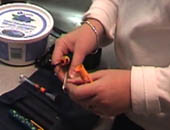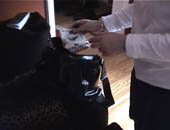Probing Deeper
What kind of input can we get from customers?
Involving customers in the design process is more than just asking them what they want and then building it for them. (If only it were that easy...)
People who use a product are only experts at using that product in their particular environment. They aren't aware of costs, new technology, or even what other customers want. They also don't have to invest, produce, sell or even buy the final product, so they have much less responsibility than members of the design team. As a result, there is a need for healthy skepticism when involving customers in design. It's not that we can't trust what people say, it's just that it can be dangerous to take things at face value, and not probe the deeper motivations behind what people say and do.
Visiting people in their own environment allows us to double-check our interpretations of why people do what they do, and to better uncover the deeper assumptions behind their statements.


Sue joked about how disorganized she was while preparing to give herself an insulin injection.
An example of uncovering
"Sue" participated in a study for a project about diabetes. She kept her equipment that she needs for her injection (e.g. insulin, pen, needles) in separate bags. This made the process for injecting quite difficult, and she herself even joked about having "bits and pieces", and how disorganized she was.
The temptation in hearing a direct statement of a need is to start to design something to address that need, and help her to be more organized. But there is more to this theme of organization.
In another video clip, Sue spoke about changing batteries in her blood glucose meter. She told me that the battery is a strange kind that she can't buy everywhere, so she keeps a spare battery in another small bag. And just to be certain, she even has a backup glucose meter in the house. For Sue, having backup systems for managing her diabetes is crucial.
The cost of "not keeping all her eggs in one basket" is increased management of her supplies. At first glance, this appears to be simple disorganization, but the fact is, it is her intentional way of increasing redundancy. If she forgets her purse somewhere, then she can still do her injection. If she had all her needles in one "convenient" carrying case, then losing that case would be a disaster.
This type of insight is not something that can be revealled with direct questions. Having backup systems is "obvious" to Sue, and it is difficult for people to identify these "common sense" assumptions and beliefs. However, from hearing Sue's (and other customer's) stories a design team can identify these larger issues behind a product, and then start designing a product that addresses (or at least isn't in conflict with) these issues.
Things are not always what they seem on the surface, so it is important to probe into what users say and do. Customer input is a rich starting point for design discusssions, not the final word.
![Pronounced [Zin-site] Xinsight logo](/images/xinsight_reveal_dark.gif)





